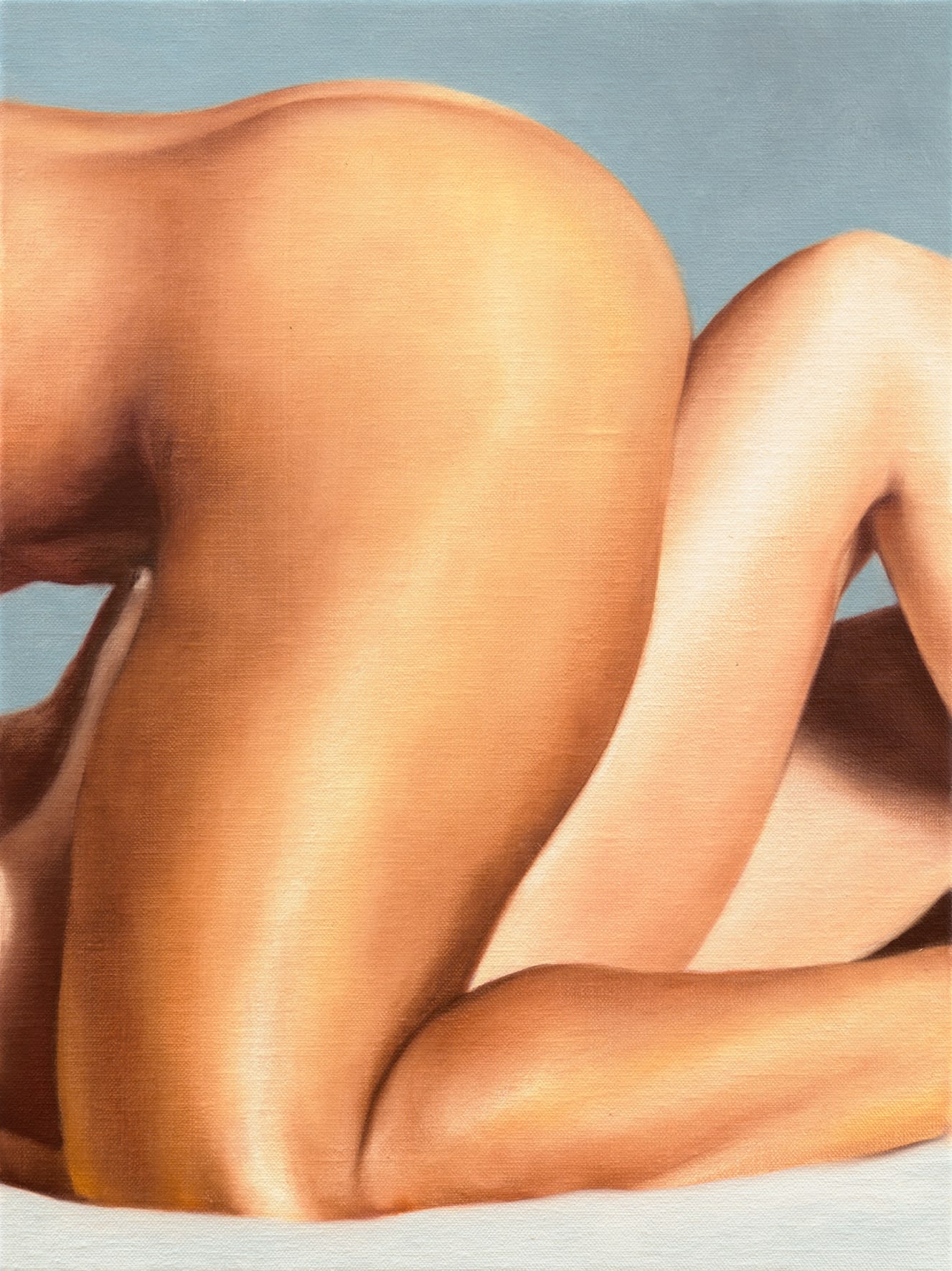The human body has long been a powerful subject in art, symbolizing beauty, strength, identity, and more. Contemporary artists such as Jasper Hagenaar, Pace Taylor, and Morag Caister are now pushing these boundaries, reimagining what the body can represent. Through their unique use of form, colour, and style, they explore nostalgia and intimacy, sparking conversations about how we view ourselves and others. All three artists have several pieces in our current portrait exhibition ‘Embraced – A Lived Experience’, ending on the 31st of August.
Dutch painter Jasper Hagenaar, who has been exhibiting his work for over two decades, has truly mastered the technique of creating contemporary art with a beautifully aged and faded appearance. His exclusive use of watered-down oils on paper, combined with abundant light, gives the bodies in ‘The Couple 6’, ‘The Couple 4’, and ‘The Couple 5’ an almost otherworldly quality. The highlighted forms—toned biceps holding slim buttocks, delicate hands caressing broad chests—appear almost oiled, with their lack of defining features placing each couple in a perfect, naked bubble.

40x30cm

40x30cm

40x30cm
Hagenaar’s art is often centred around ideas of memory, nostalgia, and ‘boyhood fantasies’, and these pieces are no different. Through intimate and detailed depictions of people touching, Hagenaar’s works are a contrast to the years we went through in Covid and a celebration of what we had temporarily lost. The recreation of boyhood fantasies is created through his faded palette, as though we, and Hagenaar, are looking back on a fond memory. The idealised human forms caressing one another creates a neutrality, contrasting the potential perversion of a fantasy. Due to the cut off framing, there is very little confirmation of any gender, making each piece a perfect snapshot of physical affection for us to place ourselves within.
Pace Taylor, a non-binary artist from Portland, has their portrait ‘Red Fruit’ in our current exhibition. Their use of surreal colour and stark contrast between the figure and the background provide a barrier we cannot ignore. Unlike Hagenaar’s nudes, inviting us to enter, ‘Red Fruit’ shows an internal intimacy we are not allowed to join. This barrier could be for protection or accidental, but either way it speaks of separation, and not belonging. Taylor has previously said they use bright colours for the feeling of them on their eyes, as well to present big feelings that a natural colour palette just cannot access.

76.2x55.88cm
The nudity in Taylor's piece ‘Red Fruit’ is particularly intriguing, especially considering their gender identity. They’ve expressed that “I like to think of all of my subjects as nonbinary or gender fluid”, which positions this work not just as a portrait, but as a statement on gender fluidity. The piece is unmistakably a nude, with the title prompting us to the subject touching their own nipple, the ‘red fruit.’ Given Taylor’s perspective, the nude transcends its conventional role and becomes a medium for personal reimagining. The subject's face is deliberately androgynous, their scalp bare, challenging traditional gender identifiers. While the viewer's attention is drawn towards the nipple, Taylor prompts us to recognize the subject’s fluidity - this is a body without a gender, captured in an intimate moment. Taylor’s work frequently explores themes of intimacy and who we choose to share it with. ‘Red Fruit’ offers us intimacy; a glimpse into a queer moment of self-connection that is both deeply personal and universally relatable. The piece pushes the boundaries of what we are accustomed to seeing, encouraging us to broaden our understanding of identity and intimacy
Morag Caister is an acclaimed British portrait artist, having won Sky’s Portrait Artist of the Year in 2022, and with her portrait of Sir Lenny Henry now hung in the National Portrait Gallery. She has two pieces featured in our current exhibition, as well as a solo show ‘Peacetime’, starting at Rhodes Contemporary Art Gallery from the 13th of September – 5th of October 2024.
Caister's portraits are known for her sparing yet intentional use of colour, and her piece 'Rowena' (2024), currently on display, is no exception. In this work, Caister takes the classic subject of the reclining nude and infuses it with a modern, deeply personal approach to colour and technique. The pastel tones and soft light throughout the piece create a connection between Rowena and her environment, as though we are witnessing her true home. The subtle harmony of pinks between her body and the rosebud cushion provides a striking contrast to the greens and blues of the surrounding sofa. Caister's focused use of colour and brushstrokes, particularly in Rowena's face and, interestingly, her feet, draws the viewer's attention to these areas amidst the faded cushions and her pale, smooth form.

Oil on Okawara Paper
100x140cm
Caister's artistic exploration centres on understanding the world and existence through portraiture and the nude. By painting each individual as they appear to her, she delves into what makes each sitter uniquely themselves - where colours emerge, where detail is necessary. The nude serves as an ideal medium for this exploration, presenting the subject at their most vulnerable yet clearly at ease with the artist and their portrayal. Through her use of repetitive lines and carefully chosen colours, Caister not only captures the essence of her subject but also reveals her own emotional connection to the art of portraiture.
For more information on Morag Caister’s, Pace Taylor's, or Jasper Hagenaar's works, or to register your interest in adding their works to your collection, email info@rhodescontemporaryart.com
August 14, 2024

